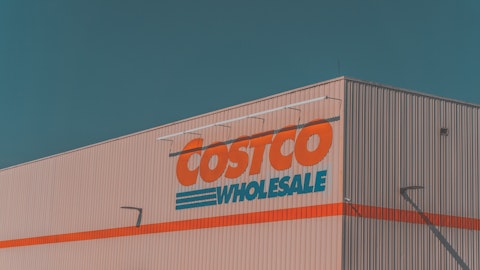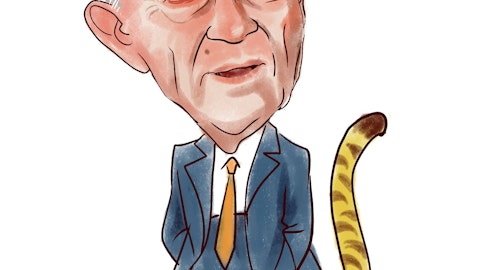In this article we discuss the 5 best spring stocks to buy now. If you want to read our detailed analysis of these companies, go directly to the 10 Best Spring Stocks to Buy Now.
At Insider Monkey we leave no stone unturned when looking for the next great investment idea. For example, lithium mining is one of the fastest growing industries right now, so we are checking out stock pitches like this emerging lithium stock. We go through lists like the 10 best hydrogen fuel cell stocks to pick the next Tesla that will deliver a 10x return. Even though we recommend positions in only a tiny fraction of the companies we analyze, we check out as many stocks as we can. We read hedge fund investor letters and listen to stock pitches at hedge fund conferences. You can subscribe to our free daily newsletter on our homepage. Keeping this in mind, let’s take a look at the best spring stocks to buy now:
5. NXP Semiconductors N.V. (NASDAQ: NXPI)
Number of Hedge Fund Holders: 53
NXP Semiconductors N.V. (NASDAQ: NXPI) is a Netherlands-based company that makes and sells several semiconductor products. It was founded in 1953 and is placed fifth on our list of 10 best spring stocks to buy now. The company’s shares have returned more than 77% to investors over the course of the past year. NXP is one of the leading semiconductor manufacturers in the world and is uniquely poised to take advantage of a semiconductor shortage in the market in recent months that has increased chip prices drastically.
NXP Semiconductors N.V. (NASDAQ: NXPI) is a good option for income investors as the firm pays a regular and sizable dividend. On May 27, the firm declared a quarterly dividend of $0.5625 per share, in line with previous. The forward yield was 1.07%.
Out of the hedge funds being tracked by Insider Monkey, Washington-based investment firm Fisher Asset Management is a leading shareholder in NXP Semiconductors N.V. (NASDAQ: NXPI) with 1 million shares worth more than $211 million.
In its Q1 2021 investor letter, Alger, an asset management firm, highlighted a few stocks and NXP Semiconductors N.V. (NASDAQ: NXPI) was one of them. Here is what the fund said:
“NXP Semi conductors was among the top contributors to performance during the quarter. NXP Semiconductors provides high performance semiconductor solutions for a wide variety of applications, including automotive, mobile communications, consumer technology, computing, wireless infrastructure, lighting and industry. We believe NXP has an attractive cyclical tailwind with the economic reopening due to its exposure to the automotive industry and the growth of the Internet of Things. NXP’s shares performed strongly after the company said it has generated revenue growth and provided healthy forward guidance driven by an improving global macro that is evident in decreasing channel inventory levels and solid pricing.”
4. The Walt Disney Company (NYSE: DIS)
Number of Hedge Fund Holders: 134
The Walt Disney Company (NYSE: DIS) is a Los Angeles-based mass media and entertainment company. It was founded in 1923 and is placed fourth on our list of 10 best spring stocks to buy now. The company’s shares have offered investors returns exceeding 41% over the past twelve months. With the rollout of the COVID-19 vaccine, business activities have resumed across the world and the firm will be a top gainer in the post-pandemic economy as people starved for entertainment frequent several Disney theme parks.
In quarterly earnings for the second fiscal quarter, posted earlier in May, The Walt Disney Company (NYSE: DIS) reported earnings per share of $0.79, beating market predictions by $0.53. The revenue for the second fiscal quarter was more than $15 billion, missing market estimates by over $300 million.
Out of the hedge funds being tracked by Insider Monkey, Washington-based investment firm Fisher Asset Management is a leading shareholder in The Walt Disney Company (NYSE: DIS) with 10.3 million shares worth more than $1.9 billion.
Harding Loevner, in their Q4 2020 investor letter, mentioned The Walt Disney Company (NYSE: DIS). Here is what the fund said:
“One of the original constituents of the Nifty Fifty holds a place in our portfolio today. When we bought Disney three years ago, we wrote that “we view Disney theme parks in the US, Europe, and China as resistant to online substitution.” We did not reckon on a pandemic, which closed all of them, and sent all of usto our couches. Disney, however, was ready for us, brilliantly illustrating the importance of management foresight and change management. Or, as Louis Pasteur said, “chance favors the prepared mind.”
A century after its founding in 1923, Disney is in the middle of a bold shift from its legacy media networks & entertainment model—with cable TV, theme parks, and theater films dominating its earnings—to a direct-to-consumer streaming media model. The keys to Disney’s transition: matchless storytelling, coupled with financial strength. The company reliably creates content that people all over the world are eager to consume. It also hastened spending on original content to attract subscribers to its new streaming platform. These factors have allowed Disney to weather the pandemic having expanded its direct engagement with customers. Such connections yield a rich harvest of insights used to customize offerings on a mass scale, reinforcing that engagement in a virtuous circle and thereby raising the lifetime value of each customer. Subscribers to Disney+ reached 86.8 million one year after launch, compared to the 60 – 90 million management projected to reach in 2024. To be sure, Netflix, Apple, and Amazon remain formidable competitors in new-era streaming entertainment (mind what we said about everyone standing up at once), but there’s fight left in this old dog.”
3. Delta Air Lines, Inc. (NYSE: DAL)
Number of Hedge Fund Holders: 50
Delta Air Lines, Inc. (NYSE: DAL) is a Georgia-based airline company. It was founded in 1924 and is ranked third on our list of 10 best spring stocks to buy now. The company’s shares have returned more than 34% to investors over the past year. Besides operating an air carrier, the company also offers related services such as aircraft maintenance, repair, and overhaul. As vacation destinations become tourist hotspots in the post-pandemic economy and aircraft bookings improve, Delta is one of the stocks that is likely to register handsome gains after a disappointing 2020.
On June 3, Delta Air Lines, Inc. (NYSE: DAL) boosted guidance numbers for the second quarter of 2021 on the back of increasing travel demand. The company said it expected leisure travel to be 100% recovered from the 2020 lows by the end of June this year.
At the end of the first quarter of 2021, 50 hedge funds in the database of Insider Monkey held stakes worth $1.09 billion in Delta Air Lines, Inc. (NYSE: DAL), down from 58 in the preceding quarter worth $1.05 billion.
In one of their investor letters, Miller Value Partners highlighted a few stocks and Delta Air Lines Inc. (NYSE: DAL) is one of them. Here is what the fund said:
“Delta Air Lines Inc. (DAL) declined -1.38% over the period after the initial hit to the stock in 1Q following the outbreak of the COVID-19 pandemic. The company reported 1Q results with EPS of -$0.51, in-line with consensus. The company guided for June revenue to be down 90% YoY and announced another $1B cut to capital expenditures (CAPEX) for a total cut of $3B so far this year. The company ended the quarter with $6B in liquidity and they expect to end the June quarter with $10B in liquidity. Delta held its annual shareholders’ meeting where it noted that it expects to finish the 2nd quarter with over $15B in liquidity with a daily cash burn of $30M getting to breakeven by the end of the year.”
2. Costco Wholesale Corporation (NASDAQ: COST)
Number of Hedge Fund Holders: 56
Costco Wholesale Corporation (NASDAQ: COST) is a Washington-based company that owns and runs popular membership-only retail stores. It was founded in 1983 and is placed second on our list of 10 best spring stocks to buy now. The stock has offered investors returns exceeding 24% over the course of the past year. As one of the largest retail brands in the world, Costco revenues are set to increase with the full resumption of business in the coming weeks. Some of the products that Costco is famous for include beef, organic foods, and others.
On June 3, Costco Wholesale Corporation (NASDAQ: COST) reported that comparable sales for the month of May had increased by 22.8%, just missing market estimates of 23.4%. The company also posted a 12.1% increase in comparable e-commerce sales for the period.
At the end of the first quarter of 2021, 56 hedge funds in the database of Insider Monkey held stakes worth $4 billion in Costco Wholesale Corporation (NASDAQ: COST), down from 61 in the preceding quarter worth $3.6 billion.
In its Q1 2021 investor letter, Ensemble Capital, an asset management firm, highlighted a few stocks and Costco Wholesale Corporation (NASDAQ: COST) was one of them. Here is what the fund said:
“We saw these dynamics at play in the Fund. Some of the worst-performing stocks this quarter were among our best performers in Q1 2020. Another example was the market’s reaction to Costco Wholesale (1.5% weight in the Fund) during the quarter. From December 31, 2020 to March 8th, Costco shares declined 17% and dropped below their pre-pandemic high. The common rationale offered by sell-side analysts was that Costco would face difficult one-year “comps” (i.e. same-store sales, which compare sales from stores open for at least a year). Because so many consumers rushed to Costco ahead of shelter-in-place and subsequent quarantines, it will be harder for Costco to meaningfully beat those results when compared year-over-year. That may indeed be true, but we struggle to understand how Costco could be “less valuable” than it was a year earlier when it concurrently increased its membership base by over 7%, or 3.9 million members. With membership renewal rates around 90%, the vast majority of the new customers Costco brought in last year will be around for years to come.
Analysts also complained about Costco raising its already industry-leading minimum wage to $16/hour, with an average “effective” pay of $23-$24/hour when you include overtime and bonuses. Costco paying its employees “too much” has been a common gripe of Wall Street analysts for at least two decades. While the extra pay does indeed impact short-term profit margins, it also serves to make Costco more durable, as its flywheel (i.e. a virtuous value cycle) starts with happy employees. A 20-year chart of Costco stock price is evidence that this strategy works and we’re confident that it will continue to work.”
1. Amazon.com, Inc. (NASDAQ: AMZN)
Number of Hedge Fund Holders: 243
Amazon.com, Inc. (NASDAQ: AMZN) is a Washington-based technology company. It was founded in 1994 and is placed first on our list of 10 best spring stocks to buy now. The company’s shares have returned more than 29% to investors over the past twelve months. Amazon is one of the biggest tech firms in the world with a wide range of business interests that include retail, artificial intelligence, web services, as well as food delivery and medical diagnostics.
On June 3, Amazon.com, Inc. (NASDAQ: AMZN) was named among the ‘Top of the Crop’ picks of investment advisory Credit Suisse, a list of the top picks from among the top 40 Outperform stocks on the portfolio of the advisory.
Out of the hedge funds being tracked by Insider Monkey, London-based investment firm Citadel Investment Group is a leading shareholder in Amazon.com, Inc. (NASDAQ: AMZN) with 3.3 million shares worth more than $10.5 billion.
In its Q1 2021 investor letter, Hayden Capital, an asset management firm, highlighted a few stocks and Amazon.com, Inc. (NASDAQ: AMZN) was one of them. Here is what the fund said:
“Amazon (AMZN): We sold our last remaining stake in Amazon this quarter. Amazon was our longest-running investment holding, after having originally purchasing it at the inception of Hayden in 2014, at a price of ~$317.
I gave some details of how Amazon has progressed over these past 6.5 years in last year’s Q2 2020 letter, which partners can find here (LINK). The company has executed amazingly well over this tenure, with revenues up ~3.3x and since our initial purchase, and reported operating income up ~30x over that period.
Generally, I believe there are three reasons to sell an investment: 1) we recognize our initial thesis is wrong (sell out as quick as possible), 2) we have a significantly higher returning opportunity to redeploy the capital into (sell-down to fund the new investment), or 3) the company is maturing and hitting the top part of it’s S-curve / business lifecycle, so the business has fewer places to reinvest its capital internally. As such, the future returns will likely be lower than the past. This investment thus becomes a “source of capital” in the future, as we fund earlier-stage investment opportunities.
In the case of Amazon, we decided to sell due to the third scenario. I’m sure Amazon will continue to generate value for shareholders and continue to keep pace with the broader technology sector. However, I’m just not confident it’s as attractive an investment as when we first invested.
With ~51% of US households having an Amazon Prime account (and with very low churn), each of these households continuing to increase their annual spend with Amazon, and few / no real competitors in sight, Amazon is a dominant force that will only continue to accrue value as consumers continue to move from offline to online purchases for their everyday needs. Likewise, the “cash-flow machine” of Amazon Web Services is in a similar position of strength, with AWS now having ~32% market share and continuing to grow at +30% y/y. Because of this, I think Amazon is probably one of the safest investments in the technology sector today.
So why did we decide to sell the investment then? Simply put, Amazon is in a much different place than when we initially invested. Back in 2014, investors were starting to question whether Amazon’s promise of future earnings potential would actually come to fruition.
Operating income had declined from ~$1.4BN in 2010, to ~$676M in 2012, to just ~$178M by the end of 2014. Expenses were outpacing revenue growth, and investors were questioning whether Amazon’s expenses were truly “investments” as they claimed, or whether it was a structural necessity of the business and thus would never flow to investor’s bottom line.
The critical question was ‘what portion of expenses are truly growth investments vs. structural expenses, and as a result, will Amazon ever be capable of generating significant profits?’
Our analysis indicated that these expenditures truly were the former, and led to the belief that the business’ structural margins would inevitably increase over time. This was our differentiated insight / investment edge.
Fast-forward to today, and our thesis proved correct with operating margins having increased from ~0.2% to ~6%. However due to this success and proving this facet out to investors, Amazon investors have much higher confidence and a better understanding of the company today. I’m not sure we have the same level of differentiated insights, as we did back then.
In addition, I believe the departure of Jeff Bezos and his long-time lieutenants signal a regime change. Perhaps it’s now “Day 1.5” instead of the Day 1 mentality that made Amazon so successful (LINK)… The departures within the past couple years include:
- Jeff Bezos – Founder, CEO, Visionary. Started Amazon in 1994.
- Jeff Blackburn – Joined Amazon in 1998. Oversaw Amazon Marketplace, Advertising, Amazon Studios, Prime Video, Prime Music, M&A.
- Jeff Wilke – Joined Amazon in 1999. Oversaw Amazon Consumer (ecommerce) business.
- Steve Kessel – Joined Amazon in 1999. Oversaw Physical Stores, Kindle, and Whole Foods.
Blackburn, Wilke, and Kessel have each arguably created hundreds of billions of shareholder value. On top of this, Bezos is the visionary and culture-setter behind Amazon. When he and his long-time lieutenants take their hands off the wheel, it is probably time for us to as well.
We sold our remaining shares at an average price of ~$3,240. Based on our initial investment, we made a ~10x return in a little over six years, for a ~45% IRR7. We reinvested the proceeds into our existing portfolio, taking advantage of the prices offered by this latest market draw-down.”
You can also take a peek at 10 Blue Chip Dividend Stocks Hedge Funds Are Buying and 14 Best European Dividend Stocks To Buy.





